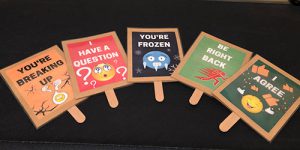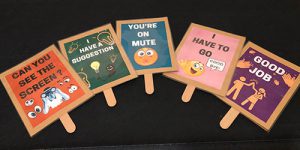Remembering the Past as We Define the Future
Sastry G. Pantula, Dean of the College of Natural Sciences, California State University, San Bernardino
What a year it has been! Zoomed out. We have gone through a lot, and it has not been kind to any of us. Every one of us probably knows someone personally who lost a loved one, lost a job, was affected by racism, was shaken in disgust by the insurrection at the Capitol, or is dealing with longer-term impacts of COVID-19.
Please take a moment to reflect on your own challenges, your resilience, your network of friends, and your support system during the past 15 months. Please be grateful and thank everyone who has been a cheerleader for you before we rush back to a new normal soon. I am thinking about you and about your struggles and triumphs. Yes, there is a bright light at the end of the tunnel. Thanks to science, statisticians, and vaccines, we will be back together this fall!
It was March 5, 2020, while I was in Fresno attending a California State University (CSU) engineering deans meeting. I received a text from our advancement team that a donor event I was supposed to attend at the Disney Museum in San Francisco on March 7 was canceled due to a cruise ship docked nearby and the potential for catching some virus. I had to cancel my flight to San Francisco and hitch a ride back to San Bernardino with another dean. That was my last trip, and I haven’t taken a flight since then.

These Zoom cards were a Christmas gift to Pantula from his provost, Shari McMahan, and came in handy during several Zoom meetings each day.
The virus was spreading fast last March, and we had to make a quick decision to pivot to virtual learning on our campus. We decided to start our spring 2020 quarter a week late and provide some quick help for our faculty to think about virtual teaching/learning. Our faculty stepped up and worked hard to make it work—mostly winged it. Campus visits for final interviews for faculty recruiting went virtual, while some searches got chilled/paused/canceled. Staff learned how to work from home and carried computer equipment and some furniture home. Students needed to borrow laptops and hotspots from the university.
It was clear last spring how the pandemic was having a differential impact on our diverse communities—women, minorities, first-generation students, the LGBTQ+ community, those who are on financial aid, and others. We ended the spring quarter by giving our students an option to take a credit/no credit rather than a letter grade in their courses. The most important day for a student—graduation—went virtual and robbed many first-generation graduates of excitement.
When we realized we were in it for the long haul, we invested significantly in providing training for our faculty during summer 2020. Faculty received stipends to attend workshops on teaching better virtually and continued the training during the academic year. We made extra effort to recruit students virtually and our enrollments were still down. It wasn’t the same to do new student orientation virtually and connect students and families with our beautiful campus.
We missed our family trip to the East Coast for a friend’s wedding (which was changed to a simple wedding at her parents’ house with no guests) and missed seeing everyone in Philly at JSM 2020. Summer was short since we were switching from quarters to semesters for the first time at our university.
During fall 2020, the realization of isolation was setting in and it was clear we would be working, teaching, and learning from our homes for the academic year. Teaching in semesters for the first time felt extra long due to the pandemic. Campus saw some budget cuts, as well as loss of revenue from parking, housing, dining, events, and enrollments. We began to learn to do more with less. Twenty-two new faculty who were hired in fall 2020 have not set foot on campus yet, and some may still have not moved to California. We developed policies for offering hybrid courses, especially labs, and limited research on campus. The impact of teaching, working, or learning from home while sharing computers, Wi-Fi, and space with family and pets was significant on our faculty, staff, and students. Again, disparities among diverse groups were stark.
Interesting Zoom backgrounds in home offices led to creative virtual backgrounds. Faculty were given an option to exclude some student opinions on teaching effectiveness and postpone tenure clocks. Students experienced more projects than finals, as well as testing with ProctorU.
By spring 2021, we were dealing with the impact of the elections and various racist incidents against African Americans and Asians. The campus held weekly virtual seminars about Black Lives Matter, policing, and xenophobia. The impact of Zoom, increased electronic communications, lack of personal interactions, multitasking, and listening to student struggles every day was wearing our faculty and staff down, and I could sense that everyone was exhausted, maybe close to being burnt out.
The good news is that vaccines are approved on an emergency basis, and there is a bright light at the end of the tunnel that we can see. By the end of March, my family was fully vaccinated, and so are the majority of our staff and faculty. We have been encouraging our students also to get vaccinated and, in May, we distributed donuts to everyone who got vaccinated on our campus. Of course, the governor of California has now announced $116.5 million dollars to give away using a lottery for those who get vaccinated. We are giving incentives to get people to be vaccinated here, whereas people are desperate to find vaccines in some parts of the world. Shows our privilege. As more people get vaccinated, we will all be safer.
There was some good news about an improved economy, budget restoration, and universities receiving stimulus funds through COVID-19 Economic Relief funds (CARES Act) and Higher Education Emergency Relief Funds (HEERF), which helped recover the losses and invest in the future. Most importantly, it provided much-needed support for our students.
During this past year, I have missed our students, taking selfies with them, passing out Donuts with the Dean, having celebrations, going to commencement, chance meetings, hallway chats, campus food, travel to meetings, and—of course—JSM. When we return to campus, I will miss being in multiple Zoom meetings at once; the ability to mute or turn off the video to grab a bite; wearing T-shirts; weekly game day with staff; and seeing Asha, Sobha, and Gracie (family) often. But I am looking forward to seeing people in person, celebrating successes together, being present, and not wearing a mask. I know we will continue many efficient electronic processes that were developed during the past year—less paper/printing, virtual advising, and having distinguished seminars and panels that were possible only virtually. I am very grateful to our faculty, our staff, our students, our administration, our IT group, our health care workers, and my family for making the last year one where we could thrive, not just survive.
The future looks brighter. We are going back to campus starting July 6 in a staggered way so there is no traffic jam with computer equipment and furniture coming back to college. More than 93 percent of our classes are scheduled to be face-to-face on our campus. Assuming the vaccines are no longer approved only for emergency use, vaccines will be mandated on our campus. Our classrooms are being outfitted to be Next Generation Smart Classrooms to broadcast some of our lectures synchronously to a few students who may not be able to come to campus sometimes.
Most of our faculty, staff, and students are eager to come back, but some are certainly anxious about it—whether it will be safe, whether child care and schools will be open, how the vaccine mandate or regular COVID-19 testing will be implemented, etc. Some faculty chose to retire early, and one junior faculty member resigned. We have lost much in student learning and faculty research. It is time for us to be back and create a new normal. I remain optimistic, and I hope you are too. We will all work together again and, at CSUSB, We Define the Future!



















